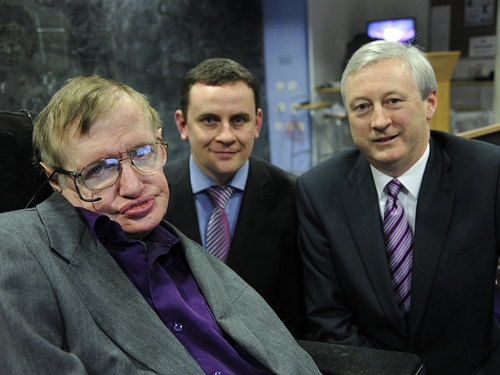
Physicist Stephen Hawking in 2013 with David Fleming, manager of the Intel Innovation Open Lab in Ireland, center, and Martin Curley, vice president of Intel Labs Europe (Intel Free Press/Flickr)
5 November 2015. Participants from universities in the U.S. and Taiwan are winners of a challenge to develop mathematical models that predict variations in progression of ALS in patients with the disease. The Dream ALS Stratification Prize4Life Challenge is a joint undertaking of Sage Bionetworks, a not-for-profit biomedical research organization, Dialogue on Reverse Engineering Assessment and Methods or Dream Challenges that pose crowdsourced questions on systems biology and translational medicine, and Prize4Life, an ALS advocacy organization in Israel encouraging unconventional methods to find innovative solutions for the disease.
Amyotrophic lateral sclerosis or ALS, also known as Lou Gehrig’s disease, is a progressive neurological disease that attacks the nerve cells controlling voluntary muscles, such as those in the arms, legs, and face. In ALS, muscles gradually weaken and waste away, leading to individuals losing their strength and their ability to move their arms, legs, and body. When diaphragm and chest wall muscles fail, people lose the ability to breathe without ventilatory support, often leading to death from respiratory failure.
One of the mysteries of ALS is the wide variation in survival time from the disease. The average lifespan of people with ALS is 3 to 5 years, with 90 percent of individuals having the disease living 7 years or less. Physicist Stephen Hawking, however, is living with ALS for more than 50 years. This continuing question of survival time makes difficult the design of new treatments and clinical trials for those treatments, as well as developing personalized therapies.
The Dream ALS Stratification Prize4Life Challenge is an attempt to find answers to this question by encouraging researchers from the scientific community at large to mine and analyze data on patients with ALS. Participants in the challenge were asked to create computer models that identify subgroups of ALS patients according to clinical outcomes, then further identify a small set of factors that predict those outcomes. Participants in the challenge were given access to the Pooled Resources Open-Access Clinical Trial or PRO-ACT database that contains records from more than 9,000 ALS patients taking part in clinical studies. The challenge was first announced in June 2015 and closed in September, with either individuals or teams allowed to participate.
Because of the complexity of the challenge, its organizers divided the competition into sub-challenges, and allowed participants to take part in as many as four of these subsidiary contests. The winners, selected for three of the sub-challenges, are:
– Sub-challenge 1. Wen-Chieh Fang, a postdoctoral researcher at National Cheng Kung University in Taiwan, with colleagues from the university’s computer science and information engineering department .
– Sub-challenge 2. Yuanfang Guan, a professor at University of Michigan, with colleagues at the school’s computational medicine and bioinformatics department.
– Sub-challenge 3. Jinfeng Xiao, a Ph.D. candidate at University of Illinois at Urbana-Champaign in the university’s biophysics and quantitative biology center, who participated as an individual.
The challenge drew 70 participants from 30 teams in 15 countries. Winners share a purse of $28,000, which was raised by a crowdfunding campaign. Further financial support was provided by pharmaceutical companies Eli Lilly and Company and Biogen, with IBM donating computing resources. Winners will have an opportunity to present their models at a Dream-sponsored conference later this month and co-author a paper to appear in the journal Nature Biotechnology.
This latest challenge is an outgrowth of a similar but smaller competition in 2012 to find algorithms that predict progression of ALS among patients overall, which Science & Enterprise reported at the time of its announcement. The results of that challenge, published in Nature Biotechnology in November 2014 identified two algorithms that outperformed a method designed by the organizers of the competition, as well as predictions by ALS clinicians. The authors estimate their models could reduce clinical trial enrollments by about 20 percent.
Read more:
- Alliance Mounts Comprehensive ALS Research Program
- Trial Testing Respiratory Muscle Drug for ALS Patients
- Foundation Supporting ALS Pilot Clinical Trials
- Stem Cells Shown to Stop Decline for Some ALS Patients
- Clinical Trial Proposals Sought for ALS Treatments
* * *

 RSS - Posts
RSS - Posts
[…] Winners of ALS Variation Models Challenge Announced […]